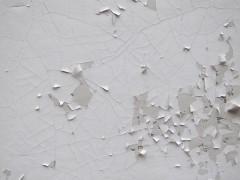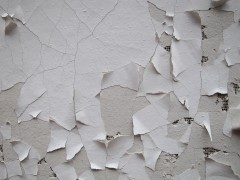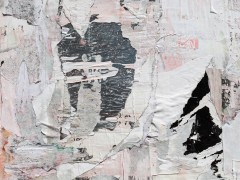Gabriel de la Mora – T.O.E.F.M.U.T.I.T.O.A.I.I.
November 9th – December 29th, 2012
Sicardi Gallery, Houston
For his second exhibition at Sicardi Gallery Gabriel de la Mora presents some of the representative series of his recent production together with other works that account the wide spectrum of techniques, reflections and questions which have sprung throughout his artistic trajectory. Within the exhibition the main traits that characterize his body of work are highlighted: the fascination for painting as a phenomenon, the artist’s attraction for the materials he employs –or finds–, and an exhaustive and over-controlled handwork that nearly reaches an artisanal level. Within de la Mora’s artistic practice the processes required to develop each piece are a central element and acquire the same relevance than the finished work.
The main room of the gallery reunites series that, even if visually similar, are carried out through inverse processes: ones are born from the artist’s obsession for an object or a specific material, often in decay, and others are shaped thanks to de la Mora’s manipulation of diverse materials.
The first of these series is composed by paintings created from plafonds that are ripped from ancient houses, some of them more than a hundred years-old and almost falling down, and the artist commands its removal. Later on a painting restorer consolidates and mounts them on an identical-size linen canvas. Next to them are the paintings made from eggshells in which the artist carefully places, one by one, minute pieces on a wooden surface.
The outcome of both series are medium and large format paintings that create a convoluted landscape even if they dismiss the use of pigments and traditional materials. Irregular lines come out unexpectedly from the canvas and color the surface of uncountable hues.
Gabriel de la Mora’s work places itself within the limits of painting, discipline onto which he poses questions and takes them to the ultimate consequences. Besides from its iconoclastic nature, his art practice occasionally flirts with the idea of the found object and the ready-made, creating a sort of hybrid between these and painting. That is, through apparently simple interventions, de la Mora transforms objects and materials into painting.
Following this path is the series made of poster paintings. After observing how the lamps and walls of Mexico City’s streets host a thick accumulation of publicity posters, de la Mora decided to rip these off. Avoiding any alteration, he places them on a canvas from the unprinted side —therefore canceling their function and points out the visual qualities that spring from the paper overlapping, the deterioration caused by the weather and by the passing of time. This is one of the traits that define most of his work: an aesthetic of ruins. The plafonds, posters, the dry acrylic painting, the erased daguerrotypes (and older series as the burnt papers), all these apparent waste or materials on the verge of disappearance are appropriated by de la Mora who, through various treatments to avoid their final fate, keeps them in a decadent state and evidences their fragility.
If the posters are waste from a society of consumption, materials that have lost their utility, de la Mora is interested as well in what could be called detritus from art history. Carrying on with his role as an art collector, a fairly eccentric one, the artist has bought paintings by Mexican authors who never got any recognition or who couldn’t insert their oeuvre within the market. Their works, rubbish in the eyes of the original owners, were sold to the artist for amounts as low as 5 or 10 dollars. Agustín González “El Cuty” 2005 I, is a canvas from which the paint was scraped and what originally was a figurative depiction became an abstract piece. Following the phrase that has been fundamental for his practice, “art is neither created nor destroyed, it is only transformed”, de la Mora creates a second painting by using the scraped oil, placing the residues on a flat and white surface.
Even if he constantly aims to expand its possibilities and modes of existence, Gabriel de la Mora’s relation with painting is a strange and complex one. Although it is a a genre that obsesses him and inhabits most of his concerns, he approaches it in aggressive, convoluted ways. Painting is violated, desacralized: the artist burns, perforates, and rips the canvas, he traces on it figures made out of human hair. The line that separates drawing, painting, or actions becomes a blurry, undefinable one. At some other moments his attacks are more poetic and he fills the pictorial surface with vulgar, everyday materials such as Post It flags, styrofoam balls, or just leaves it empty and occupies its space with the reflection of an object. The work 3,936 capas de pintura 4A-4B is performed by an exhaustive, seven months-long process in which coats of acrylic paint are overlapped. Each layer cancels the previous one by covering its surface. As the accumulation of the material acquires great volume, the painting transforms itself into a sculpture.
Contrary to the logic of preserving matter in a state of frozen decay is the series of intervened photographs. Within his activity as a collector, de la Mora buys a large number of old photographs and works on them. In 508 W he carefully tears off small pieces from a pornographic image and places them in the precise spot that corresponded to each in the original picture. The deconstructed image is rendered inaccessible. The other intervened photographs are images from Mexican and American films, and even if exhibited in the gallery they are works-in-progress as they will only be finished when time and light consume their colors and transform them into white monochromes.
“The only excuse for making a useless thing is that one admires it intensely”, a phrase culled by de la Mora from The Portrait of Dorian Gray, was chosen to title one of the newest works of the exhibition, T.O.E.F.M.U.T.I.T.O.A.I.I. 1[from its initials in Spanish] a canvas burned by the artist that will remain frozen in such state previous to disappearance. In the preface of the aforementioned book, Oscar Wilde continues to comment on art and beauty and states that those who go beneath the surface do so at their own peril. Gabriel de la Mora takes this as a command in which he doesn’t only go beyond the surface but he plays with it, empties it, fills it, transforms it… De la Mora’s oeuvre not only shows the admiration he feels for the lines and textures he creates or finds but he achieves to generate it in every spectator.
Fabiola Iza
Willy Kautz 2012
Practical info
1506 West Alabama Street Houston, TX 77006, United States
Tel: (713) 529-1313
www.sicardi.com


 Home
Home


